
INDUSTRY UPDATE: Female Executives
Introduction
Considering that 45% of the European workforce and 47% of the US workforce are female, it is certainly fair to question why the female share of executives hovers around 27%. Yes, there has been progress, but still only 10% of CEOs at Fortune 500 companies are female (the highest level in 68 years). “One of the main factors that hinder women from achieving equality in the United States is that employers simply do not handle these issues actively…” concludes one source.
That is where the Diversity, Equity, and Inclusion (DEI) initiatives were or are supposed to effect change. Forbes describes the current state of these initiatives as follows:
Social change often comes in bursts. Two steps forward, one step back, as the old adage goes.
DEI is social change—change that, sadly, takes time. For those growing impatient with the increasing polarization and political misrepresentation of DEI, 2024 will be more of the same. The U.S. presidential election is likely to further polarize and politicize DEI much as it did in 2020.
Dr. Martin Luther King famously said, “the arc of the moral universe is long, but it bends towards justice.”
[The author concludes:]
I remain cautiously optimistic about the future of DEI. It will happen. It needs to happen. Yet, change takes time. [See source.]
Another source goes on to provide inspiring short profiles of 31 female CEOs while reminding readers that female managers tend to be more productive than their male counterparts as well as better at fomenting more cooperative, less combative business cultures.
Of course, motherhood may well be one reason for the gender gap. Apparently, 75% of US mothers of children under 18 are employed full time and 61% believe that being a mother “disrupts their ability to progress in their careers.” [See source.] One of the remedies expected to address this disparity is the implementation of paternity leave or paid family leave. So far, in the US 22 of the 50 US states have enacted this in some form. Europe is more advanced on this front where the UK and all 27 EU states have introduced minimum family leave policies.
Is there truly progress then in the share of female executives active in business? One source cites a significant rise in female board membership among Fortune 500 boards (in the US), which has risen from 9.5% in 1995 to 30.4% in 2023. At the state level, 24% of governors in the US were female in 2023—up from the previous high of 18% in 2007. Are these isolated or is this progress more general?
McKinsey reports that in fact the share of female executives has increased significantly, from 17% to 28% since 2015 (based on a major study in the US and Canada). Female Vice Presidents represent approximately 33% and women comprise 36% of the Director/Senior Manager level. The study goes on to debunk myths about women in the workforce concluding:
- Women are more ambitious than before the pandemic—and flexibility is fueling that ambition;
- The ‘broken rung’ (not the glass ceiling) is the greatest obstacle women face on the path to senior leadership;
- Microaggressions have a large and lasting impact on women; and
- Men and women see flexibility as a ‘top 3’ employee benefit and critical to their company’s success [See source.]
The study also underscores the importance of flexibility and its relevance to women:
As workplace flexibility transforms from a nice-to-have for some employees to a crucial benefit for most, women continue to value it more. This is likely because they still carry out a disproportionate amount of childcare and household work. Indeed, 38 percent of mothers with young children say that without workplace flexibility, they would have had to leave their company or reduce their work hours.
In Europe, female employees occupy 35.1% of management positions, though there is significant variation between a low of 22.8% in Luxembourg and a high of 45% in Latvia. Among the largest countries, female management has the following shares: Poland (42.9%), France (39.9%), Spain (43.7%), and Germany (28.9%). [See source.]
Most prominently, let us remember that the EU itself has a female President, Ursula von der Leyen, who is putting much effort into expanding opportunities for her gender. Europe has actually set targets for female representation now, prescribing that 40% of certain executive positions should be occupied by women by 2026. However, at least one source suggests there is still a long way to go:
- 44% of European financial services directors appointed in 2023 were female, down from 51% in 2022;
- 59% of all directors appointed in 2023 brought C-suite experience, but just 38% were female, down from 47% in 2022;
- 31% of firms still report under 40% female board representation, with women holding the most senior board positions* at just 29% of firms. [See source.]
The UK has also set targets for female executives that suggest a company’s board should be made up of at least 40% women.
This has led to an all-time high of 42% female board directors at the top UK listed companies (the FTSE 100) with knock-on effects in functional disciplines. “In the FTSE 100, 25% of finance directors were female, up from 23%, and 27% of chief information officers were women, up from 21%. Women make up 30% of executive committees.” [See source.]
While overall, female executives hold a smaller share of leadership positions in the Middle East than in other regions, Forbes has come out again with its 100 most powerful businesswomen in the Middle East ranking. It headlines an impressive list of CEOs, Chairwomen, and Vice Presidents featuring a broad array of nationalities (28 in all) and industries (27 sectors). Financial services leads the way with 26% of the entries.
Will mandates and/or DEI activism bring about a lasting change in female executive participation?
DEI for one has been under siege recently, most visibly in the US, where critics have described the effort as reverse racism. This may have caused the pendulum to swing back a bit, as CNN reports:
After a more than 29% uptick in job postings with DEI in the title or description between November 2020 and November 2021, the data shows a more than 23% decline in the amount of job postings with “DEI” in the title or description between November 2022 and November 2023. [See source.]
On the whole though, major companies apparently continue to see the judicious promotion of diversity, equity and inclusion as being necessary and important. CNN continues:
More than half of the executives who answered the survey agreed that backlash toward corporate DEI efforts has increased since the Supreme Court overturned affirmative action in June, but 69% said it has not caused their organization to change its approach to DEI efforts. [See source.]
At the Barrett Group, we do see progress toward growing acceptance and support for more female executives. In fact, our new CEO, Marion Engelke, is also female. Let us now turn to the actual data on the women who make things happen at many of the world’s most important companies.
The Market for Executives
In these Industry Updates TBG regularly reviews a population currently comprising circa 11 million executives in the US, Canada, UK, EU and Middle East of which 27% is female in total, though this varies considerably by geographic market. [See the Editor’s Note for more details on which titles are included.] Of these almost 3 million female executives, 1.1 million work in the EU and UK (25% of total), where the overall executive market has grown by 1% in the past year and seen 200,000 change jobs. In the US and Canada, 1.7 million executive women (29% of total) are employed in an overall market that grew 0.6% and saw another 212,000 change jobs. In the Middle East, only 17% of the executive workforce is female, about 92,000 out of a total market that grew by 1% and saw 29,000 change jobs.
Overall, without specific reference to gender, LinkedIn reports the above-referenced executive positions as experiencing a high hiring demand and enjoying an average tenure of 3.3 years.
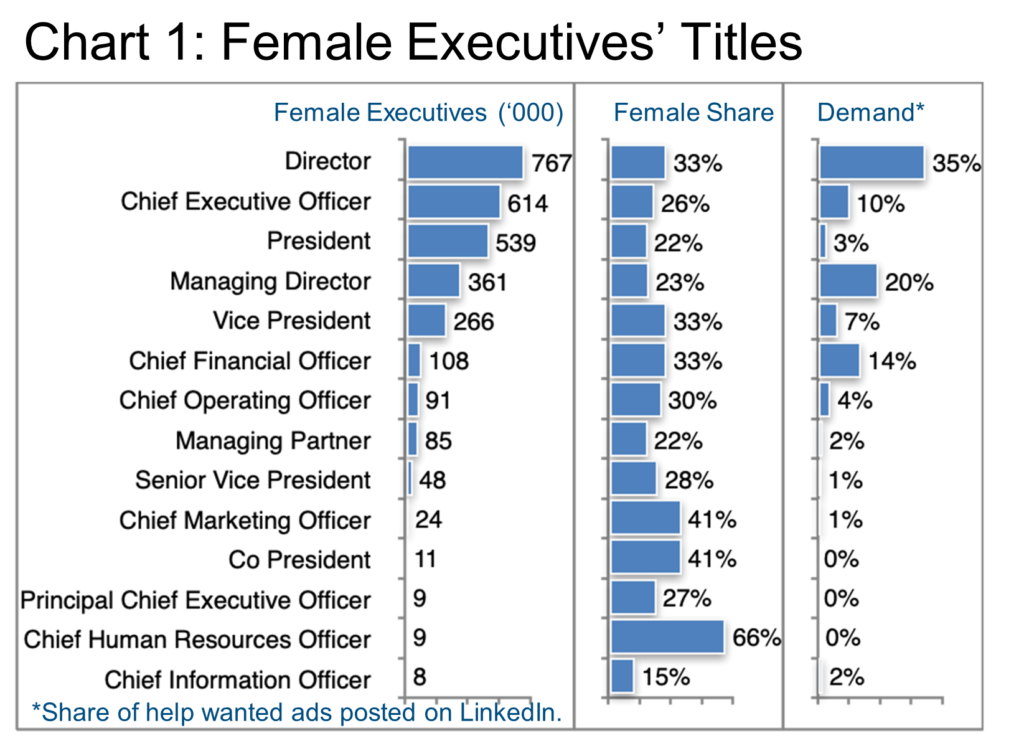
Chart 1 presents the number of female executives per major title category. For example, Director titles in our sample were 33% female according to LinkedIn, accounting for some 767,000 individuals. This position (in total and irrespective of gender) attracted 35% of the help-wanted postings on LinkedIn within this cohort and the past year.
As usual, the Chief Human Resources Officer spot attracts the highest share of female executives (66%), followed by Chief Marketing Officer and Co-President (both, 41%). While 26% of CEOs seem rather consistent with what other media are reporting, 15% for Chief Information Officers would seem to indicate considerable opportunity for improvement.
Why does the human resources responsibility consistently seem to land on a woman’s desk?
Here is one common explanation: “While men possess their own form of EQ, women tend to demonstrate more advanced empathetic and interpersonal skills, both of which are vital to resolving intra-office disputes, managing employees, and negotiating contracts.” [See source.] By the way, this source is well worth exploring in more detail as it also examines income disparity and other related issues, and reaching this intriguing conclusion: “A report from McKinsey & Company discovered a direct correlation between profitable companies and diversity, as the more diverse companies were more likely to have above-average financial returns.”
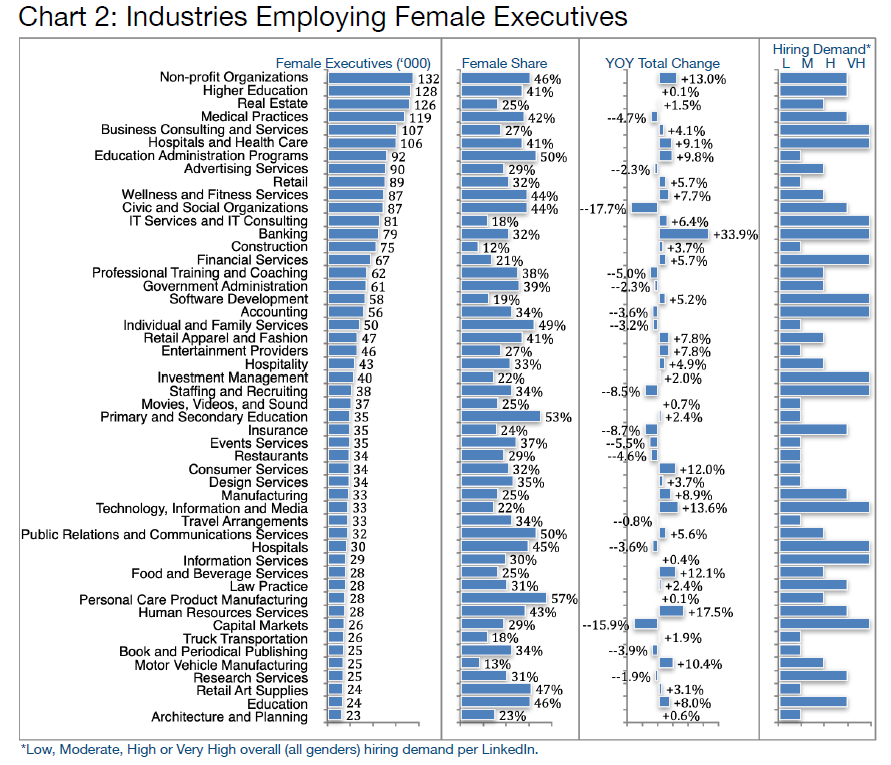
In Chart 2 readers will see the female executive population ranked in descending order per industry of employment. Obviously, this results from the size of the overall segment as well as the female share which varies tremendously from a low of 12% in Construction to a high of 57% in Personal Care Product Manufacturing according to our source.
LinkedIn does not provide gender-specific data on the YOY Total Change or Hiring Demand (columns three and four respectively in Chart 2) so this data is necessarily not gender-specific, however, it is understandable that Banking has added personnel as interest rates (and therefore retail banking’s profitability) rose while Capital Markets have tended to shed executives as Private Equity investing became more complicated and less rewarding due to the economic cycle.
Hiring Demand in Chart 2 refers to LinkedIn’s prediction as to whether the industry will continue to experience Low, Moderate, High, or Very High hiring demand in the short term.
This suggests that, for example, Business Consulting and Services and Hospitals and Health Care (both of which show relatively large populations with high female executive shares) are likely to continue to hire at a very high rate.
Scarcity can also drive this data, as seems to be the case for Civic and Social Organizations or Staffing and Recruiting both of which show high or very high demand and yet negative changes in the recent past. In other words, these industries may well be struggling to find enough qualified individuals.
TBG clients receive considerably more detailed research support during their career change programs, however, even at this level of detail it seems evident that certain industries may be more attractive for female execs wishing to take a step up. Transitioning from one industry or role to another is one of TBG’s specialties, of course, as the program helps clients rethink their overall goals early on during the targeting or Clarity Program© step. Here is one client’s take on the process:
I thought Clarity was super interesting[.] I learned a lot about the way I handle things in business, what kind of professional personality I have, and where I best fit culture-wise. (It has to be fast-paced and organized!) [Lisa – Executive Director]
Many skills are in fact transferable from one industry or specialization to another, and this can lead to big moves in candidates’ careers, especially if they have guidance from a Forbes-recognized professional career management firm such as TBG.
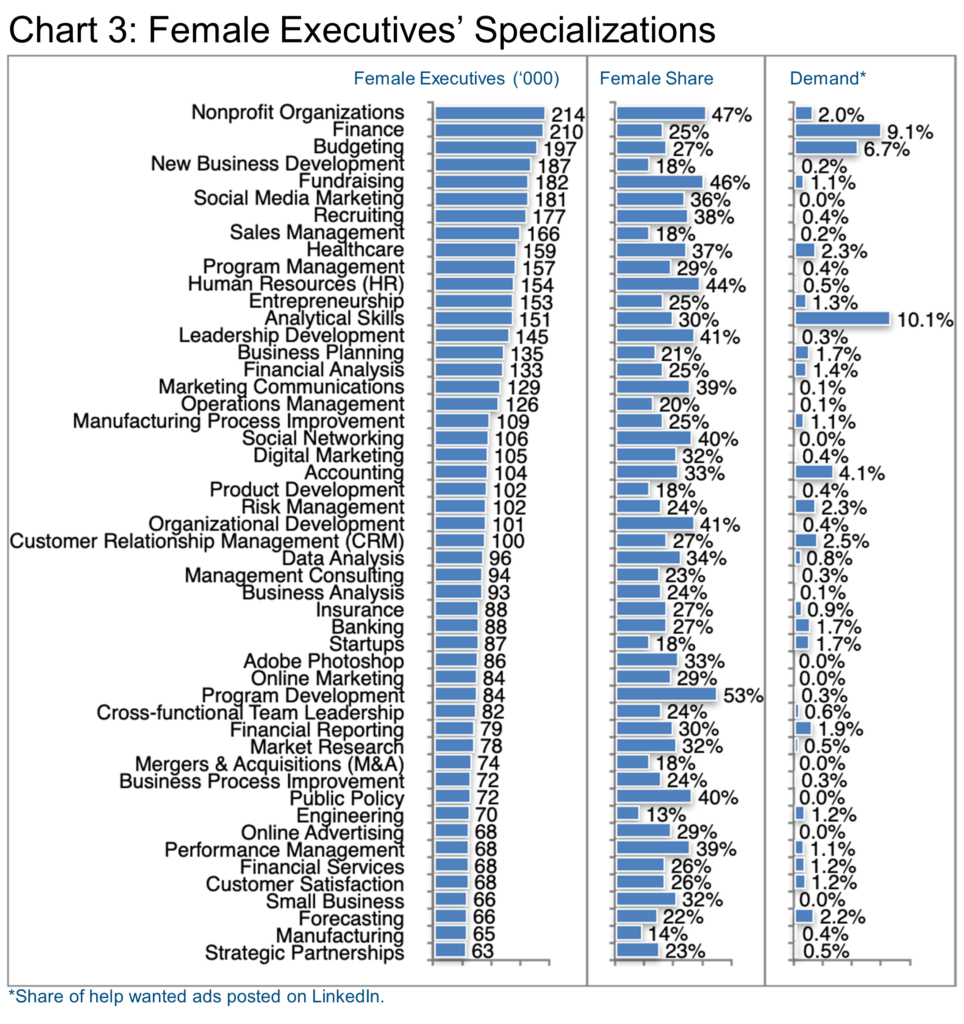
Chart 3 collects the specializations that female executives have posted on their LinkedIn profiles highlighting the relative frequency of each, the female share, and the change in the total population (not just the female execs’ share).
TBG has seen an on-going demand for Finance, Budgeting, and Analytical Skills through many of the industries we examine and this cohort is no different. As far as the female share is concerned, clearly we think women should be better represented in most specializations, however, as of now, Program Development (53%), Nonprofit Organizations (47%), Fundraising (46%), and, of course, Human Resources (44%) lead the pack.
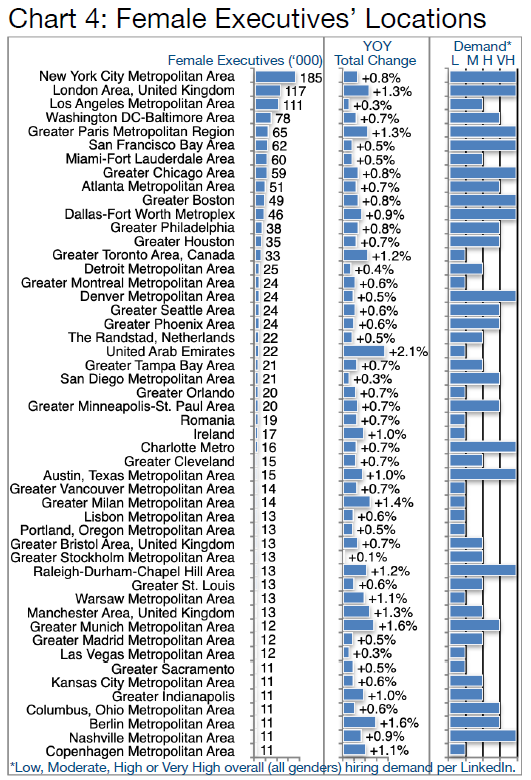
As usual, New York comes out on top with the most female executives of any location (Chart 4), though it is not growing (on an all-gender basis) as fast as London, Paris, Toronto, or even the UAE. Still, New York as well as many locations shows a high or very high hiring demand that speaks either to a scarcity of relevant professionals or increasing growth going forward.
Location is typically dictated by the employer, of course, so who are the best employers for female executives?
Recently Forbes published a list of the best companies for women, explaining their methodology as follows: “…we surveyed approximately 70,000 women working for multinational corporations across 37 countries. Participants were asked—among other questions—if they would recommend their employer to friends or family, and to rate the corporation on both general workplace practices and gender-specific issues including gender pay equity, the management of employee discrimination cases, and whether men and women have the same opportunities for advancement.”
Here are the top five companies from that list:
- MAIF (Insurance – France)
- The Estée Lauder Companies – US
- SAP (IT, Software – Germany)
- Clorox (Retail and Wholesale – US)
- Marriott International (Travel & Leisure – US)
The list is fascinating and offers much food for thought. [See source.]
Peter Irish, Chairman, The Barrett Group
Click here for a printable version of Female Executives 2024.
Editor’s Note:
In this Update “executives” will generally refer to the Vice President, Senior Vice President, Chief Operating Officer, Chief Financial Officer, Managing Director, Chief Executive Officer, Chief Marketing Officer, Chief Information Officer, Managing Partner, General Counsel, Head, President and Director titles principally located in the US, Canada, Europe, the UK, and/or the Middle East. Unless otherwise noted, the data in this Update will largely come from LinkedIn and represents a snapshot of the market as it was at the time of the research.
Is LinkedIn truly representative? Here’s a little data: LinkedIn has more than 1 billion users. (See source.) It is by far the largest and most robust business database in the world, now in its 20th year. LinkedIn Talent Insights data is derived by aggregating profile data voluntarily submitted by LinkedIn members. As such, LinkedIn cannot guarantee the accuracy of LinkedIn Talent Insights data.
Recent Female Executive Clients of the Barrett Group
Part of our mission at TBG is to help clients find relief by realizing that they are not “stuck” in a job, in a career, or an industry. They have choices, even if they do not realize it immediately. Our Clarity Program© opens clients’ eyes to broader possibilities while the remainder of our program facilitates change by applying practices gleaned from more than three decades of success, making transferability of expertise and experience much easier.
In that context, we think it might be helpful to profile a few of our relatively recent female executive clients in brief as a subtle encouragement to those still hesitating.
Samantha – External Communications Manager

As Chief Marketing Officer in the beverages industry, Samantha recognized that her job was a poor fit for her skills and inclinations. She hired TBG and reports tremendous satisfaction in her new industry and role. [Read more.]
Jocelyn Hirschfeld – Vice President of Market Access

At first Jocelyn was not sure why she should change but when she realized the opportunities available, she never looked back. [Read more.]
Diane – Vice President of Operations

After two years in a consulting role, Diane realized that she preferred and wanted to return to a corporate environment.
Through diligence and the support of her TBG team, Diane summarized her results as follows: “I had been a chief information officer. The operations officer role was something I had never really been in before. It was new and exciting, and I looked forward to it.” And, finally, like many Barrett clients, she of course had a better salary, better perks, and a better title, as well as one other outcome. “You know, I received a sign-on bonus that more than covered The Barrett Group’s fees.” [Read more.]
Elfreda – Vice President K-12 Strategy
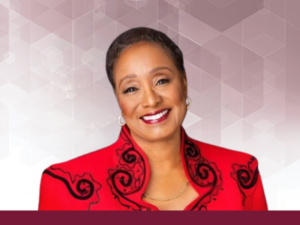
Elfreda had risen as high as she could go in her organization and wanted new challenges, however, she wanted to be thoughtful and intentional before making her next career move.
TBG helped her discover opportunities and negotiate a better package. She says, “Having a consistent coach was really helpful[.] And it was clear to me that all the people at The Barrett Group really wanted me to succeed.” [Read more.]
To read about TBG clients’ successes, click here.
TBG News:
Marion Engelke, CEO of the Barrett Group as of January 1, 2024—our first female CEO! [Read More.]













